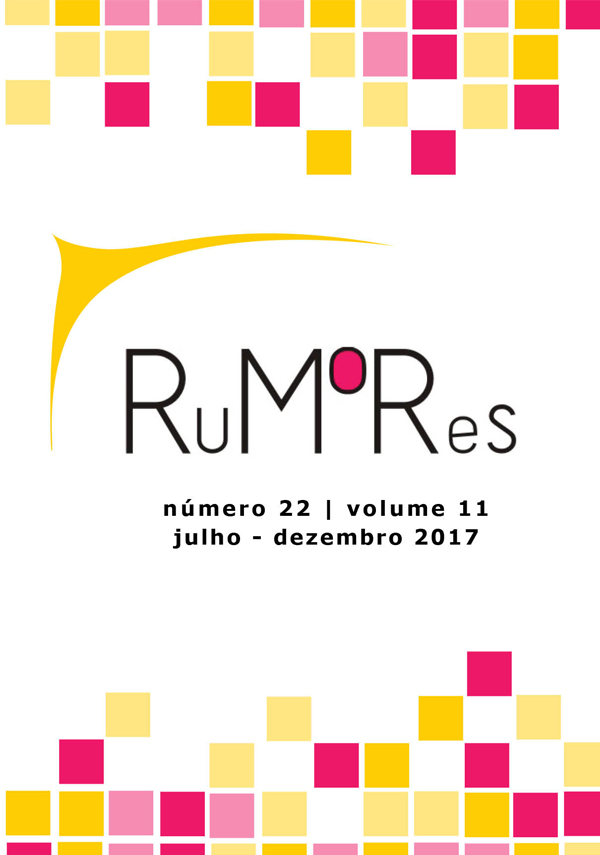Blockbusters and sucess as the antidote for the third
DOI:
https://doi.org/10.11606/issn.1982-677X.rum.2017.134309Keywords:
Imaginary, communication, cinema, successAbstract
This work aims to reflect on the symbolic conditions (Durand, Bachelard) that, in the cinema, can take part of the image of success. This, considered in its requirements of consensus and collective adhesion, is defined from the premise of the Imaginary Studies on the representations of the logical principles of antithesis, analogy and complexity, pondering that the relation with the difference is fundamental to understand the symbolic condition of success. With this premise, three of the ten films considered the greatest box-office hits of all time are analyzed: …Gone with the wind, Avatar and Titanic. It is concluded that in both Avatar and Titanic there is a dualistic approach to otherness, while in …Gone with the wind the approach is monistic. In either case, plurality is retracted, with the refusal of the Other’s effectiveness as a third party.
Downloads
References
BACHELARD, G. A terra e os devaneios do repouso: ensaio sobre as imagens da intimidade. São Paulo: Martins Fontes, 1990.
______. A psicanálise do fogo. São Paulo: Martins Fontes, 1999.
______. A terra e os devaneios da vontade: ensaio sobre a imaginação das forças. São Paulo: Martins Fontes, 2001a.
______. O ar e os sonhos: ensaio sobre a imaginação do movimento. São Paulo: Martins Fontes, 2001b.
BARROS, A. T. M. P. A fotografia no Instagram e as presenças do sagrado na contemporaneidade. In: CONGRESSO BRASILEIRO DE CIÊNCIAS DA COMUNICAÇÃO, 39., 2016, São Paulo. Anais eletrônicos… São Paulo: Intercom, 2016. Disponível em: <https://goo.gl/1rnLYo>. Acesso em: 5 jul. 2017.
______. Raízes dos estudos do imaginário: teóricos, noções, métodos. In: ARAUJO, D. C.; CONTRERA, M. S. (Orgs.). Teorias da imagem e do imaginário. Brasília, DF: Compós, 2014. p. 50-78.
CAMPBELL, J. O herói de mil faces. São Paulo: Pensamento, 2007.
CARRASCO, D. (Ed.). Introduction. In: ______ (Ed.). The history of the conquest of New Spain by Bernal Diaz del Castillo. Albuquerque: UNM Press, 2009. p. xi-xxvii.
CLIFT, J. D.; CLIFT, W. B. The hero journey in dreams. New York: Crossroad, 1988.
DURAND, G. Campos do imaginário. Lisboa: Instituto Piaget, 1996.
______. Les structures anthropologiques de l’imaginaire: introduction à l’archétypologie générale. Paris: Dunod, 2016.
FISCHER, R. M. B. O mito na sala de jantar: leitura interpretativa do discurso infanto-juvenil sobre a televisão. 1982. Dissertação (Mestrado em Educação) – Fundação Getúlio Vargas, Rio de Janeiro, 1982. Disponível em: <https://goo.gl/ GyUnJ5>. Acesso em: 3 jun. 2017.
GOLDSTEIN, L. S. Becoming a teacher as a hero’s journey: using metaphor in preservice teacher education. Teacher education quarterly, Ann Arbor, v. 32, n. 1, p. 7-24, Winter 2005. Disponível em: <https://goo.gl/3VFEvn>. Acesso em: 23 jun. 2017.
HAMILTON, J. F. Sand’s la mare au diable, Awakening through “Evil” and the hero’s journey. Nineteenth-Century French Studies, Lincoln, v. 36, n. 1-2, p. 45-60, Fall- Winter 2007. Disponível em: <https://goo.gl/HVGxDv>. Acesso em: 21 jun. 2017.
HORKHEIMER, M.; ADORNO, T. A indústria cultural. O iluminismo como mistificação de massas. In: LIMA, L. C. (Org.). Teoria da cultura de massa. Rio de Janeiro: Saga, 1969. p. 163.
MCDONALD, W. C. The boar emblem in Gottfried’s “Tristan”. Neuphilologische Mitteilungen, Helsinki, v. 92, n. 2, p. 159-178, 1991. Disponível em: . Acesso em: 23 jun. 2017.
MORIN, E. O cinema ou o homem imaginário: ensaio de antropologia. Lisboa: Relógio D’ Água, 1997.
OTTO, R. O sagrado: um estudo do elemento não-racional na ideia do divino e sua relação com o racional. São Bernardo do Campo: Imprensa Metodista, 1985.
THOMAS, J. Introduction aux méthodologies de l’imaginaire. Paris: Ellipses, 1998.
TODOROV, T. A conquista da América: a questão do outro. São Paulo: Martins Fontes, 1999.
VOGLER, C. A practical guide to Joseph Campbell’s the hero with a thousand faces. [S.l.], 1985. Disponível em: <https://goo.gl/XchxW4>. Acesso em: 24 jun. 2017.
______. The writer’s journey: mythic structure for writers. London: Pan Books, 1996.
WUNENBURGER, J. J. A razão contraditória – Ciências e filosofias modernas: o pensamento complexo. Lisboa: Instituto Piaget, 1990.
______. La vie des images. Grenoble: PUG, 2002.
______. As telas do sagrado ou o imaginário religioso da televisão. in: Intexto. Porto Alegre, UFRGS, set.-dez. 2017. p. 23-35.
Downloads
Published
Issue
Section
License
Declaro a total e irrestrita cessão de direitos autorais sobre o texto enviado para publicação na Rumores – Revista Online de Comunicação, Linguagem e Mídias. Entendo que o conteúdo do artigo é de minha inteira responsabilidade, inclusive cabendo a mim a apresentação de permissão para uso de imagens, ilustrações, tabelas, gráficos de terceiros que, porventura, venham a integrá-lo.









